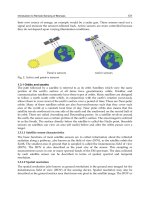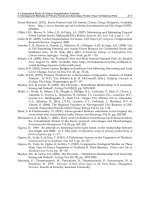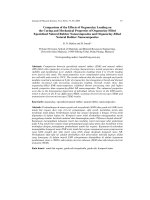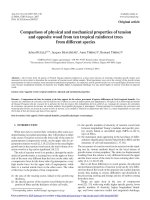Materials Science and Engineering - Electronic and Mechanical Properties of Materials Part 8 pdf
Bạn đang xem bản rút gọn của tài liệu. Xem và tải ngay bản đầy đủ của tài liệu tại đây (335.59 KB, 10 trang )
3.225
17
• Usually Clausius-Mosotti necessary due to high density of dipoles
Ionic Polarizability
(
−
++==
+
−
−+
22
2
3
1
32
1
ωω
αα
εε
α
ε
ε
oioo
tot
r
r
M
e
v
N
By convention, things are abbreviated by using ε
s
and ε
∞
:
(
++=
+
−
<<
−+
2
2
3
1
2
1
,
oios
s
oi
M
e
v ω
αα
εε
ε
ωω
[
−+
∞
∞
+=
+
−
=
+
−
>> αα
εε
ε
ωω
vn
n
o
oi
3
1
2
1
2
1
,
2
2
+
+
=
−
−
+=
∴
∞∞
∞
2
2
,
1
22
2
2
s
oiT
T
s
r
ε
ε
ωω
ω
ω
εε
εε
ε
r
ω
ω
T
n
2
=ε
∞
ε
s
© E. Fitzgerald-1999
)
)
]
3.225
18
Orientational Polarizability
• No restoring force: analogous to conductivity
H
H
O
p
+
-
C
O
O
p=0
+q
-q
θ
For a group of many molecules at some temperature:
Tk
pE
Tk
U
bb
eef
θ
cos
==
−
After averaging over the polarization of the
ensemble molecules (valid for low E-fields):
Tk
p
b
DC
3
~
2
α
Analogous to conductivity, the
molecules collide after a certain
time t, giving:
ωτ
α
α
i
DC
o
−
=
1
© E. Fitzgerald-1999
9
10
3.225
19
Dielectric Loss
© E. Fitzgerald-1999
• For convenience, imagine a low density of molecules in the gas phase
• C-M can be ignored for simplicity
• There will be only electronic and orientational polarizability
ωτ
ε
ε
ε
α
εεωτ
ωτε
α
χχε
i
n
n
N
n
i
N
n
so
r
o
DC
sor
o
DC
oer
−
−
+=
∴
+==<<
−
+=++=
1
3
, ,1
)1(3
1
2
2
2
2
We can write this in terms of a
real and imaginary dielectric
constant if we choose:
ωτ
τω
ε
ε
τω
ε
ε
εεε
22
2
so
22
2
2
1
'' ;
1
'
'''
+
−
=
+
−
+=
+=
nn
n
i
so
r
Water molecule: τ=9.5x10
-11
sec, ω~10
10
microwave oven, transmission of E-M waves
logωτ
-2
0
+2
ε’,ε’’
n
2
ε
so
α
e
+α
i
α
e
3.225
20
Dielectric Constant vs. Frequency
• Completely general
ε
due to the
localized
charge in materials
ω
ε
1/τ
ω
T
ω
oe
1
n
2
α
o
α
i
α
e
molecules
ions
electrons
Dispersion-free regions, v
g
=v
p
© E. Fitzgerald-1999
11
3.225
21
Dispersion
• Dispersion can be defined a couple of ways (same, just different way)
– when the group velocity ceases to be equal to the phase velocity
– when the dielectric constant has a frequency dependence (i.e. when dε/dω not 0)
k
ω
Dispersion-free
Dispersion
k
c
r
ε
ω
=
g
r
p
v
k
c
k
v
=
∂
∂
===
ω
ε
ω
g
r
p
v
k
c
k
v
=
∂
∂
≠==
ω
ωε
ω
)(
© E. Fitzgerald-1999
1
3.225
1
Spontaneous Polarization
Remember form of orientational polarization:
kT
C
kT
p
or
==
3
2
α
With C ≡ Curie constant
Define a critical temperature T
c
by
k
NC
T
c
0
3
ε
=
Noting further
Thus
© H.L. Tuller, 2001
or
0
3
ε
α
orc
N
T
T
=
Fig. 1. The Curie-Weiss law illustrated for (Ba,Sr)TiO
3
From L.L. Hench and J.K. West, Principles of Electronic
Ceramics, Wiley, 1990, p. 243.
1
33
00
=
=
c
kT
CNN
εε
α
c
c
TT
T
−
=
3
χ
3.225
2
• Each unit cell a dipole!
•Large P
R
(remnant polarization, P(E=0)
• Coercive Field E
C
, electric field required to bring P back to zero.
Ferroelectrics
E
R
R
o
∆E
Two equivalent-energy atom positions Can flip cell polarization by applying
large enough reverse E-field to get over
barrier
E
P
‘normal’ dielectric
P
s
E
c
P
R
© E. Fitzgerald-1999
3.225
3
Ferroelectrics
• ‘Confused’ atom structure creates metastable relative positions of
positive and negative ions
© E. Fitzgerald-1999
3.225
4
Ferroelectrics
Applications
• Capacitors
• Non-volatile memories
• Photorefractive materials
© H.L. Tuller, 2001
2
3
3.225
5
Characteristics of Optical Fiber
•Snell’s Law
n
1
n
2
θ
1
θ
2
Refraction
Boundary conditions for E-M wave gives
Snell’s Law:
2211
sinsin θθ nn =
n
2
n
1
θ
1
θ
2
Internal Reflection:
θ
1
=90°
2
1
1
2
sin
n
n
c
−
==θθ
Glass/air, θ
c
=42°
© E. Fitzgerald-1999
3.225
6
• Attenuation
– Absorption
• OH- dominant, SiO
2
tetrahedral mode
– Scattering
• Raleigh scattering (density fluctuations) α
R
~const./λ
4
(<0.8 µm
not very useful!)
•Dispersion
– material dispersion (see slide i13)
– modal dispersion
Characteristics of Optical Fiber
x
•
Light source always has
∆λ
•
parts of pulse with different l propagate
at different speeds
Black wave arrives later than red wave
Solution: grade index
y
n
n
2
n
1
© E. Fitzgerald-1999
3.225
7
Characteristics of Optical Fiber
© E. Fitzgerald-1999
3.225
8
Characteristics of Optical Fiber
© E. Fitzgerald-1999
4
3.225
9
Colors Produced by Chromium
Above: alexandrite, emerald, and ruby.
Center: carbonate, chloride, oxide.
Below: potassium chromate and ammonium dichromate.
© H.L. Tuller, 2001
3.225
10
Electron distribution in the ground state of a chromium atom (A) and a trivalent chromium ion (B).
Chromium Electronic Structure
© H.L. Tuller, 2001
5
3.225
11
Interaction of the d orbitals of a central ion with six ligands in
an octahedral arrangement.
Octahedral Environment of Transition Metal Ion
© H.L. Tuller, 2001
3.225
12
The splitting of the five 3d orbitals in a tetrahedral and an octahedral ligand field.
Note: hen the element is a mid-gap dopant, transitions within this element lead to
absorption and/or emission via luminescence
Crystal Field Splitting
© H.L. Tuller, 2001
W
6
3.225
13
Optical Transitions in Ruby
Optical absorption spectrum tied to Cr transitions in ruby.
© H.L. Tuller, 2001
3.225
14
Optical Transitions in Emerald
Optical absorption spectrum tied to Cr transitions in emerald.
© H.L. Tuller, 2001
7









